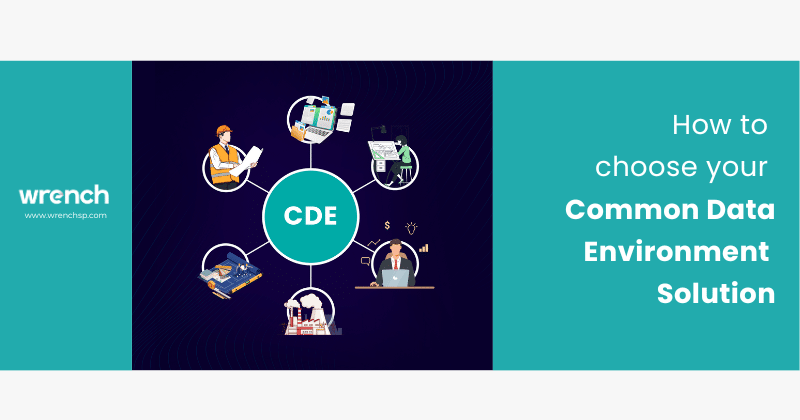- Blog CDE Common Data Environment
- 18 Jan 2024
How to Choose Your Common Data Environment Solution

Common Data environments or CDEs have become popular with engineering companies in the last few years, but choosing the right CDE software for your project can be daunting. In this post, I will lay out the top three things to keep in mind while selecting a CDE software solution.
First of all, a CDE solution must check all the boxes when it comes to functionality. What do I mean by that mean? I mean, the CDE solution must contain all the functionality YOU require in YOUR project.
Not all CDEs are created equal. Most CDE software comes with certain basic functionalities, and it is tempting to just assume those basic functionalities will be sufficient for your needs so go for one that seems ‘good enough’. But I would argue that with so many options available and constantly improving technology tools why settle for good enough? Why not pick a solution that gives you exactly what you need?
But what features and functionality should you look for in your CDE? This can be a difficult question to answer beforehand, so to figure this out, try asking yourself and your team these questions: “Is this CDE solution compatible with the file formats we use including native files?”, “Does it provide configurable access rights ie can it cater to different levels of stakeholders without impacting either our efficiency or our security?”. “Does it have plugins that will let us connect smoothly with our other software applications?” Also consider factors like the ease of access; ideally your CDE should be accessible from a variety of devices (even without a network connection) and should have workflows built-in to manage quality by ensuring everybody follows the protocols for compliance.
The more advanced CDE solution will have dashboards with analytics and these will be a big advantage during your project execution, so keep that in mind as well when evaluating a CDE’s functionality.
The second point to consider: is the CDE easy to use? Will everybody involved in the project be able to learn and use it in a reasonable amount of time?
Ease of Use is an underrated parameter when it comes to project management software even though it makes a huge difference to outcomes.
The fact is, if people aren’t comfortable using software, they just won’t use it, or they’ll use it inefficiently. And as the saying goes, a chain is only as strong as its weakest link. So you need to make ease-of-use a priority when selecting a common data environment. Consider factors like whether the software can be used by someone not familiar with BIM, and whether adds-ons and plug-ins can be installed quickly and easily without additional support. Consider whether the user interface is intuitive enough to cater to all your teams and third parties without needing to rely on extensive (and potentially expensive) recurrent training sessions and other handholding. If your project involves multiple offices across multiple time zones and cultures, it would be wise to consider how well the CDE would align with such a team as well.
Thirdly, do keep in mind the many options available in CDE Pricing and Service. Many companies start with this but that would be a mistake because just as the right CDE software can benefit your project outcome the wrong one can affect it negatively and with significant damage to the profit margin.
Here I will say that in today’s market landscape, the exact feature set you require and the number of users will be key factors in determining the price, so it is good to freeze those factors before you begin checking out pricing options. The good news is that these days there are several ways to purchase – monthly vs yearly pricing, subscription models vs outright purchase, pay per user vs pay per project, and so on. Also keep in mind that almost all these aspects can usually be negotiated, depending on the software provider.
You will also want to check out value-added services like training, whether it comes bundled or is a separate costed item, whether it is per person or project, and also whether there are other ways your team can get support and help if needed (which can be a significant factor if dealing with offshore teams). Also consider how scalable your CDE is, and how it will handle new stakeholders being added during the project, as sometimes happens, and how it will handle users being moved from one location to another.
After all this don’t forget to check out the type of support provided in your Common Data Environment platform or solution; is it email? A ticketing system, a hotline? Will there be a dedicated support manager assigned to you from the provider? Sorting out these support-related issues can be crucial to how effective your CDE is in real life.
Know More: How to get started with common data environment for BIM
Author
Shabna Madala
Shabna has over 7+ years of experience in the construction project management sector, having worked with leading consultancies like AECOM, Colliers, and CBRE. She is a Civil Engineer with a Master’s degree in Building Engineering and Management from SPA, New Delhi, and has a deep understanding of project management processes with a focus on project controls and presentation.
Related Posts

Importance of Collaboration and Communication in Project Management in EPC Projects
As the EPC industry moves steadily towards digitisation and we’re seeing the emergence of an ever-increasing array of digital project management systems and Project Management Information systems (PMIS) in project management, it’s interesting to look…
- 21 Nov 2024

EPCM Systems in the Age of Digital Transformation
It’s become commonplace to hear statements about “The Benefits of Digital EPC software’ and ‘The Future of the Construction Industry’ and ‘Digital transformation in EPC sectors’, with some pundits dubbing the current era EPC 2.0…
- 14 Nov 2024
Archives
- November 2024
- October 2024
- September 2024
- August 2024
- July 2024
- June 2024
- May 2024
- April 2024
- March 2024
- January 2024
- December 2023
- November 2023
- September 2023
- August 2023
- July 2023
- June 2023
- May 2023
- April 2023
- March 2023
- February 2023
- January 2023
- December 2022
- November 2022
- September 2022
- June 2022
- May 2022
- April 2022
- March 2022
- January 2022
- November 2021
- October 2021
- July 2021
- June 2021
- May 2021
- March 2021
- February 2021
- January 2021
- December 2020
- November 2020
- September 2020
- August 2020
- June 2020
- April 2020
- March 2020
- February 2020
- January 2020
- November 2019
- October 2019
- September 2019
- August 2019
- April 2019
- March 2019
- December 2018
- October 2018
- September 2018
- August 2018
- July 2018
- June 2018
- May 2018
- April 2018
- January 2018
- November 2017
- October 2017
- September 2017
- May 2017
- April 2017
- March 2017
- February 2017
- January 2017
